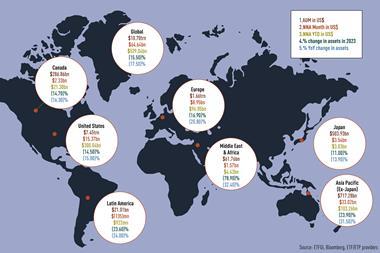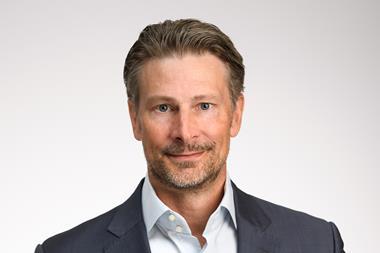The hope for providers is that one day European investors will use ETFs on the scale seen in the US. The instruments can be used in many different ways, they say, and within these uses, have advantages over some of the more conventional investment tools.
“The main use I still see is in equitising cash,” says Deborah Fuhr, executive director at Morgan Stanley in London. If you are running a fund, and are not allowed to use futures or choose not to do so, then ETFs are a good way of keeping assets invested in the market. And ETFs can be very practical tools for sector rotation, tactical asset allocation and global balanced, says Fuhr.
Pension funds and institutions are broadening their reach, but many lack the staff resources to cover all markets. “Over the last year over so, people have said that with head counts being cut, we can’t realistically add value by being in all those markets.” They have chosen instead to pick stocks in some areas and use ETFs in others.
This trend towards increased use of ETFs which are based on international indices can be seen clearly from figures in the US. In the third quarter of 2004, assets of international ETFs were up 72%, while assets of other ETF only grew by 12%.
“The other thing we’re seeing is pension funds using ETFs as overlays,” says Fuhr. This happens at funds which have some in-house investment, but which have most of their asset management outsourced. When the inhouse management decides to, for example, overweight the US, it can do this using ETFs without disturbing the country-specific mandates it has in place.
Futures contracts can, of course, be used to achieve overlays in this way. But ETFs can be less expensive even than using futures, and on top of this, the trading risk relative to benchmark is less with an ETF than it is with a future. And with an ETF, there is no necessity to roll the contract over.
ETFs can be shorted, she points out, adding that each month, 20% of outstanding ETFs have been shorted. Gary Gastineau, managing director of ETF Consultants, says the most widely-used ETFs in the US, the QQQ and the SPDRs have at least four times the short interest of any other security.
ETFs can also be lent, says Fuhr, and the revenue from this can be more than the management fee of the ETFs themselves.
Chris Sutton, chief executive of iShares Europe and Asia (ex Japan) says pension funds and institutions tend to use ETFs in two contexts: within existing portfolios and as separate investments outside. Within portfolios, pension funds mostly look at ETFs and compare them to swaps and other derivatives. They use ETFs in order to make sure they stay fully invested. Particularly in April and May when the majority of European stocks pay dividends, ETFs are a quick and easy way of ploughing that money back into equities.
Within portfolios, ETFs are starting to be used for the implementation of investment policy, he says. The instruments are used to make short-term asset allocation moves, for example underweighting bonds temporarily when it becomes appropriate.
“More and more people are doing this via ETFs,” says Sutton. If they did not use ETFs, the alternative would be either derivatives or taking possession of actively managed assets. But if a pension fund were to take assets away from its managers in order to implement such short-term moves, this would be problematic for the fund manager. It would be a distraction from their main job.
“Adding value through stockpicking is harder these days; what you don’t want (as a fund manager) is the distraction of having stocks taken away,” he says.
Alain Dubois, head of European ETFs at State Street Global Advisors, says ETFs are easy to use, especially in comparison to futures and swaps, which require legal compliance.
The use of ETFs as separate investments outside portfolios is less pronounced than their use within portfolios, but it is growing. It allows exposure to new asset classes and new styles of investing, says Sutton. BGI will be talking to pension funds about this type of use in 2005, he says.
The market climate is just right for this. Equity markets, he points out, have returned in the last 18 months, but it is still relatively hard to find good returns. “We are seeing an increasing appetite for exposure to new asset classes,” he says, pointing to areas such as emerging markets - China and Asia - and smaller companies. Within fixed income, credit of different types and international bond exposure; real estate and commodities are also being targeted.
A number of pension funds and their managers are perfectly comfortable with the theory of spreading their investment nets wider to include new types of asset, says Sutton, but they are not so confident about the application. iShares, he says, are a good way for pension funds to dip their toes into these markets.
“And you know what you’re doing is transparent – you can go to iShares.net any day and see what is in your portfolio,” he says.
The simplicity that ETFs offer can mean boards use their efforts more effectively. “Boards of pension funds think about their governance budget. What they spend it on is thinking about the long-term asset allocation. Whether you invest in China – not how you invest – that is how you get the most value from your budget.”
The best ETF applications for pension funds are not necessarily in the most visible products, says Sutton. For example, the iShares FTSE 100 product is the single most visible ETF in the UK. “Although it is used, the FTSE 100 is not at the top of pension funds’ most important asset type,” he says. Where they are more likely to find uses for ETFs is in other markets, particularly where there is an absence of futures contracts.
“Using the sterling iBoxx product is a useful way of building up exposure without rushing headlong into the over-the-counter market,” he says.
ETFs can be very effective tools in transitions, where asset allocation is being changed to some degree. The instruments can offer immediate exposure to the target asset class while the details of the longer-term investment portfolio are being worked out. Dubois of SSGA says that this use comes into its own particularly for medium-sized and smaller pension funds.
If a fund is switching some of its allocation from Europe to Asia, for example, he says, the money in question can be parked easily in Asian ETFs. Over a six-month horizon, this is one of the cheapest ways to do this.
ETFs can allow pension funds to reallocate without going through the cumbersome programme of issuing RFPs, says Dubois. “It’s not a way to avoid going in front of your board, but from time to time you have to move quickly,” he says.
In many cases, particularly with major and complex transitions, pension funds use the services of a transition manager. And in turn, transition managers may use ETFs as part of the operation in order to smooth the transition. “To do a transition using ETFs would be relatively simple,” says Marc Russell-Jones, vice president of alternative investment services at Bank of New York, in London. “With seven ETFs, you could do a full global transition.”
Investors are using ETFs to hedge themselves, says Dubois. “An ETF in this context is a value-added tool,” he says. If you take a view, for instance, that European technology stocks are about to dive, then you can protect yourself by selling the sector ETF short.
There are now many ETFs competing in the same sectors and indices. How do pension funds choose between them? Dubois says it is a simple matter of opting for the cheapest ETF – the one with the highest volumes and tightest spread. Fees vary, though how they affect the buyer depends on how long they intend to keep the ETF. “Spread is more important,” he says.
Also, some ETFs pay dividends while others do not. Investors may opt for those which do not carry a payout, because it has less implications for their tax status. “You may prefer not to have the administrative burden,” he says.
There is very little price difference between competing ETFs, says Chris O’Brien, vice president marketing and sales, S&P Europe and Asia. Total expense ratios are comparable for ETFs within similar investment spheres, for example large caps. However, emerging markets ETFs would naturally as a group have higher total expense ratios.
In any case, ETFs tend to be held for such a short period, that the cost of them becomes virtually irrelevant in many cases. “The expense pans out to negligible statistical noise because it’s only being held for a short time,” he says.
The important thing is to choose an ETF which is broad-based and compliant with the Global Industry Classification Standard (GICS), so that it blends into an existing portfolio. O’Brien says investors need an ETF which moves in lockstep with the exposure they are trying to gain.
Russell-Jones sees the increase in passive investment driving the growth in the use of ETFs. In the UK and US, between 20% and 25% of pension assets are passively allocated, but there is a lower level in some continental European countries.
In France, since 1997 there has been 100% growth annually in passive investment, albeit from a low starting point. Now some 3-3.5% of assets are passively invested in the country.
There is still a real need to educate investors about ETFs and their uses, say those behind the instruments. The exchanges have a huge role to play in this, says Marc Russell-Jones, noting that the Swiss Exchange is doing most work at the moment in terms of education.
“I think you’ll continue to see institutional demand once they get a taste for them,” he says.












No comments yet